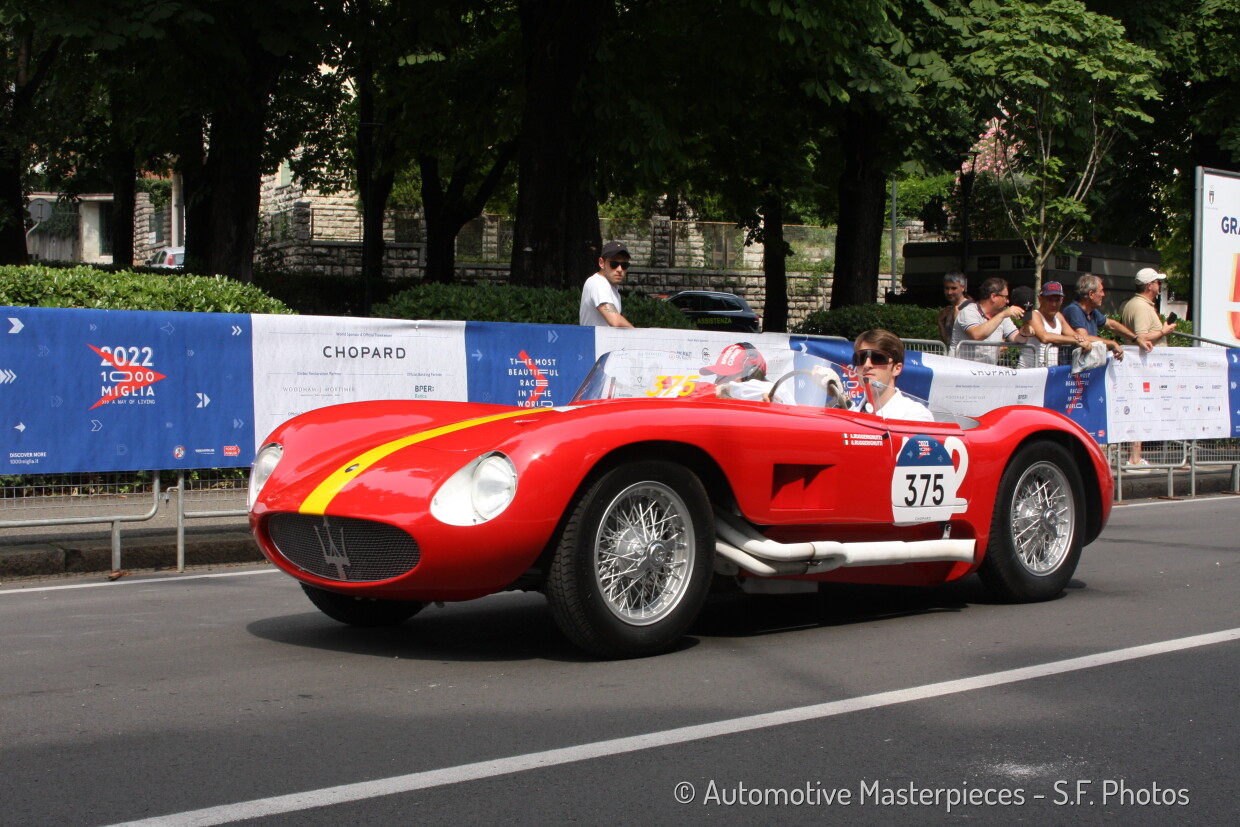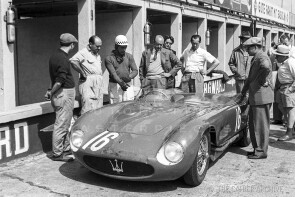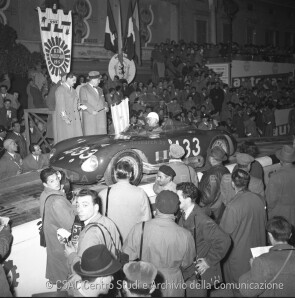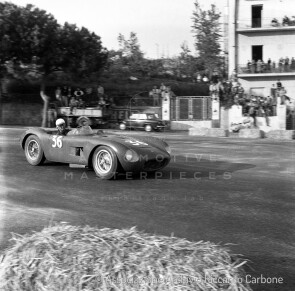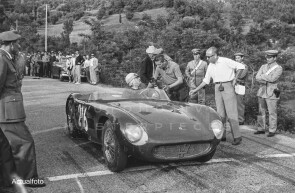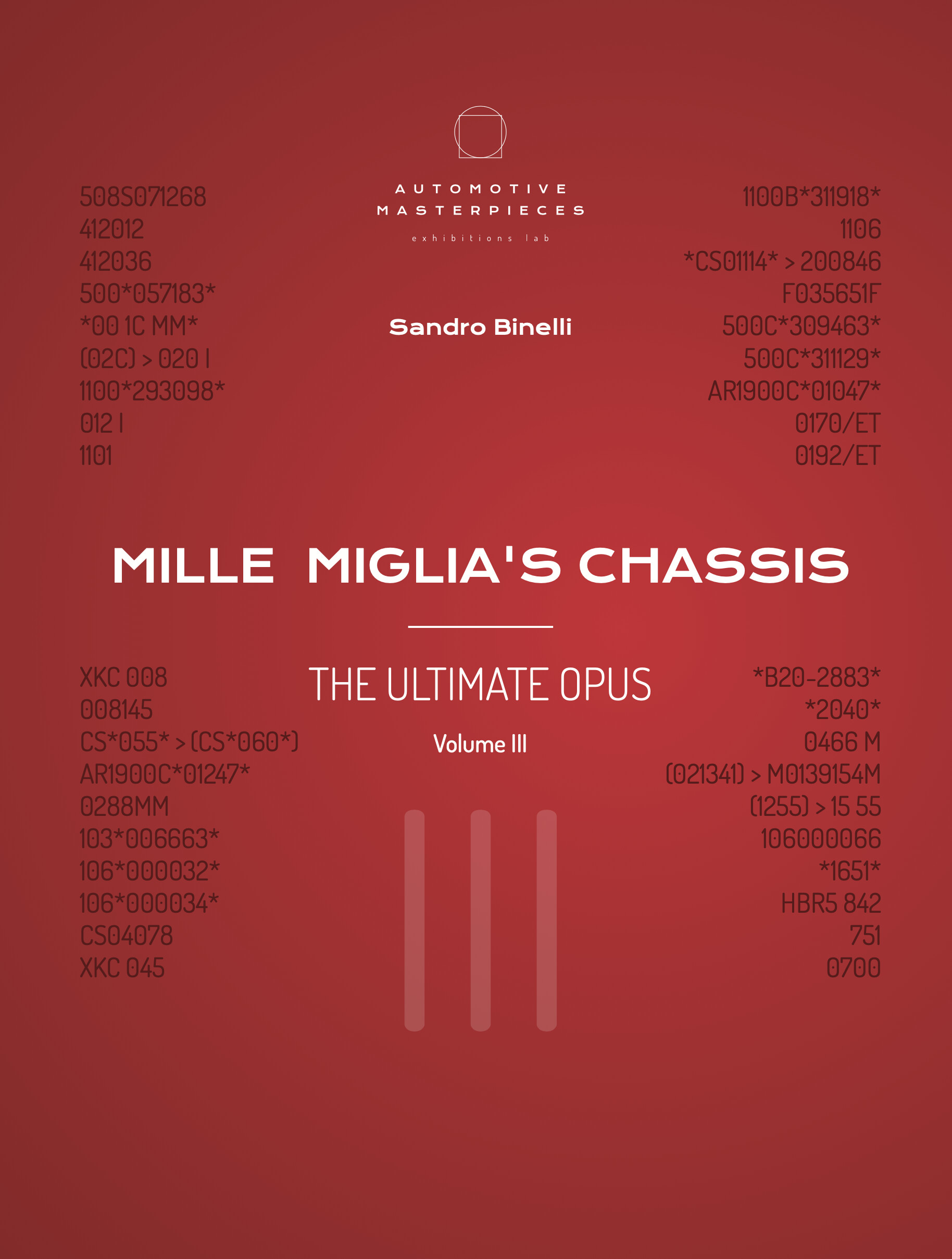
1955 Maserati Sport 150/S
ON/OFF
Why am I an Automotive Masterpiece?
H. Works cars
Officine Alfieri Maserati SpA (IT)
J. Movie cars
Checkpoint (GB)
K. Famous chassis’ cars
The first chassis pf 150/S built
L. Limited edition cars
no. 25 manufactured, 1st built
The Sport 150/S is a competition car built in 25 examples from 1955 to 1957. It is believed that, with the realization of the project known as “Tipo 53”, Maserati management intended to conquer the lucrative US market, where compact European sports cars were preferred by sporty customers over the bulky American cars. However, Maserati's commercial expansion plans were limited to competition cars, which were intended to serve as a launch and promotional support for a road-going grand tourer version that never materialized. Similar to the 200/S, the 150/S was meant to replace the now uncompetitive A6 GCS and marked the return of the four-cylinder engine to racing. The intent to design a car with a 1.5-liter inline four-cylinder engine was related to the Maserati brothers' projects before World War II. While the design phase was swift, the realization took time due to Maserati's commitments in competitions. Vittorio Bellentani, head of the project, started with the engine design, using the 4CF2 as a reference. The new engine, developed from Alberto Massimino's earlier 2-liter, balanced the need for simplicity with advanced technology and was a “super square” design despite concerns about high rotation speeds. The large piston surface made the use of twin spark a given. The power achieved was 140 hp at 7500 rpm. The first experiences took place in powerboating, which provided valuable testing: in October 1954, the first 150/S engine was installed on the Maria Luisa IV hull, which Liborio Guidotti drove to a world record. The gearbox made for the 150/S was novel, integrated with the engine block, featuring Porsche synchronizers, initially four and later five speeds and was often paired with a ZF limited-slip differential. The chassis was a subject of study and program uncertainties. Finally, thanks to engineer Giulio Alfieri, coil spring front suspension and a modern and refined De Dion suspension with transverse leaf spring at the rear were approved. The structure was of a tubular trellis type, built by Fiandri & Malagoli. In April 1955 Maserati unveiled the 150S at the Salone dell’Automobile in Torino, and a series of tests was orchestrated by Guerino Bertocchi; due to the technical staff's commitments in other production areas, especially the more commercial ones, at least a dozen potential sports customers were involved in these tests to define the car and correct defects. The bodies were similar to the 300S, but their smaller size gave them a more massive and rounded appearance, almost all made by Celestino Fiandri. With a weight within 630 kg, the car reached speeds of 230 km/h. The production started in 1955 with chassis no. 1651, considered the prototype and remained "in-house." Chassis no. 1654 was the first delivered, while no. 1652 remained temporarily in the plant, and no. 1653 was rethought, with the wheelbase lengthened from 2150 mm to 2250 mm, a solution adopted on all the 150/S from no. 1656. The spectacular debut of the 150/S was by Jean Behra on August 28, 1955, at the Nürburgring 500 Km, where he overwhelmed 13 Porsches. The success immediately provoked numerous requests from private buyers. Many cars were sold to private customers; in fact, to be homologated by the FIA in the relevant category (“sports prototypes” in this case), they had to be produced and sold in a certain number, otherwise considered pure prototypes. Among the first buyers of the 150/S was Alejandro De Tomaso. It seems that eight 1955s first series were built, and second series followed during 1956 with new shapes. Thanks to racing experience, the aerodynamic aspect was addressed: an innovative approach for racing cars, although the knowledge of the time only allowed empirical solutions that, however, proved effective. Giulio Alfieri studied the behavior of the airflow under the car and the turbulence: the tail was almost truncated, the front prominent, and the bottom closed. Given the numerous requests, the construction of the chassis was commissioned to Gilco but some defeats led to a premature abandonment of further developments, while the need for significant production relegated the 150/S to a minor role. Alberto Massimino, head of Maserati's four-cylinder program, left for Stanguellini in late 1952 replaced by Gioacchino Colombo who, as well as Giulio Alfieri, preferred the six-cylinder design: the 150S/200S family was discontinued and never developed to its full potential. A swan song occurred in 1960 when the four-cylinder engine made a comeback due to customer insistence who wanted to mount it on British chassis to compete in Formula 2.
The Maserati Sport 150/S with chassis no. 1651 is the first of the twenty-five 150/S models built and was completed around July 1955, bodied by Fantuzzi. This information is validated in a letter Adolfo Orsi, heir of the Maserati heritage, appointed to conduct an expertise on the car, addressed in 2008 to Andrea Curami and Jean Sage. Orsi found that there is no assembly sheet for chassis no. 1651, but only a handwritten summary list for commercial use. Lacking the assembly sheet, we can only speculate that the chassis was from Fiandri & Malagoli, although some suggest that all 150/S chassis could have been built by Gilco. Being the first complete car produced (beyond the engine used experimentally by Guidotti), chassis no. 1651 could be the one presented at the 1955 Salone di Torino and therefore its completion is, perhaps, a little earlier. The car remained with the company until May 1959 and was used as an official “works” car in the racing seasons from 1955 to 1958. It is the car that performed the miracle at the Nürburgring 500 Km in August 1955, where Jean Behra had two cars from Maserati at his disposal: chassis no. 1651 (short wheelbase) and no. 1656 (long wheelbase). Behra won with no. 1651 ahead of 13 Porsches, astonishing everyone. Chassis no. 1651 participated in the 1956 Mille Miglia again with Jean Behra, race number 433, finishing 20th overall and second in class. Like many of the cars competing that year, the car was featured in the action film Checkpoint, which used footage from the race as a setting. In May 1956, it finished second overall at the Gran Premio di Napoli with Maria Teresa de Filippis. Also in 1956, engineer and driver Claudio Corini, known by the pseudonym “Dodo” or “Luigi Dodi”, began racing it with excellent results, often placing in the top positions overall and in class. The car, having a sporting career, received small and constant body updates to improve performance. In May 1959, Corini purchased chassis no. 1651 as a used car from the factory, and at his request, the car was updated: the 1.5 L engine and four-speed gearbox were replaced with a 2 L engine with a hemispherical head and a five-speed gearbox; driving was changed from right-hand to left-hand, all in compliance with the technical regulations in force. Corini participated in sporting events and private tests at the Modena track until 1961, and in 1962, he traded it to the Fiat Balestrieri dealership in Parma, which subsequently sold it to American Mr. L.O. Dufresne, who exported it to the United States. The car returned to Italy only in 1995, when it was bought in need of a restoration by Corrado Cuppellini through Danilo Calmonte and entrusted to Dino Cognolato for a comprehensive conservative restoration that involved only partial repair of the deteriorated aluminum parts. Cognolato documented the car's completeness in the pre-restoration phase with photographs: the only replaced part was a portion of the right side. Keith Duly with Joel Finn found a “right” mechanics: the 2 L engine has been replaced with a 1.5 L unit and four-speed gearbox, as originally fitted; not the matching one but of the correct type. Mechanics was then overhauled by renown Autofficina Omega of specialist Corrado Patella. Sold to Paolo Berton, chassis no. 1651 received a FIVA passport and participated in its first Mille Miglia reenactment in 1998, where it has since been a regular presence. It is currently fully restored according to the 1959 specifications. The car is registered in the Registro Mille Miglia and was featured in the Mille Miglia's Chassis - The Ultimate Opus Volume III book by Sandro Binelli, published by Automotive Masterpieces.
